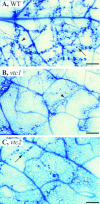The timing of senescence and response to pathogens is altered in the ascorbate-deficient Arabidopsis mutant vitamin c-1
- PMID: 15064386
- PMCID: PMC419851
- DOI: 10.1104/pp.103.032185
The timing of senescence and response to pathogens is altered in the ascorbate-deficient Arabidopsis mutant vitamin c-1
Abstract
The ozone-sensitive Arabidopsis mutant vitamin c-1 (vtc1) is deficient in l-ascorbic acid (AsA) due to a mutation in GDP-Man pyrophosphorylase (Conklin et al., 1999), an enzyme involved in the AsA biosynthetic pathway (Smirnoff et al., 2001). In this study, the physiology of this AsA deficiency was initially investigated in response to biotic (virulent pathogens) stress and subsequently with regards to the onset of senescence. Infection with either virulent Pseudomonas syringae or Peronospora parasitica resulted in largely reduced bacterial and hyphal growth in the vtc1 mutant in comparison to the wild type. When vitamin c-2 (vtc2), another AsA-deficient mutant, was challenged with P. parasitica, growth of the fungus was also reduced, indicating that the two AsA-deficient mutants are more resistant to these pathogens. Induction of pathogenesis-related proteins PR-1 and PR-5 is significantly higher in vtc1 than in the wild type when challenged with virulent P. syringae. In addition, the vtc1 mutant exhibits elevated levels of some senescence-associated gene (SAG) transcripts as well as heightened salicylic acid levels. Presumably, therefore, low AsA is causing vtc1 to enter at least some stage(s) of senescence prematurely with an accompanying increase in salicylic acid levels that results in a faster induction of defense responses.
Figures




References
-
- Agrawal GK, Rakwal R, Jwa NS, Agrawal VP (2001) Signaling molecules and blast pathogen attack activates rice OsPR1a and OsPR1b genes: a model illustrating components participating during defense/stress response. Plant Physiol Biochem 39: 1095–1103
-
- Arrigoni O, De Tullio MC (2000) The role of ascorbic acid in cell metabolism: between gene-directed functions and unpredictable chemical reactions. J Plant Physiol 157: 481–488
-
- Arrigoni O, De Tullio MC (2002) Ascorbic acid: much more than just an antioxidant. Biochim Biophys Acta 1569: 1–9 - PubMed
-
- Asada K (1999) The water-water cycle in chloroplasts: scavenging of active oxygens and dissipation of excess photons. Annu Rev Plant Physiol Plant Mol Biol 50: 601–639 - PubMed
-
- Asada K, Takahashi M (1987) Production and scavenging of active oxygen in photosynthesis. In CJ Arntzen, ed, Photoinhibition: Topics in Photosynthesis. Elsevier, Amsterdam, pp 227–287
Publication types
MeSH terms
Substances
LinkOut - more resources
Full Text Sources
Other Literature Sources
Medical
Molecular Biology Databases
Research Materials
Miscellaneous

